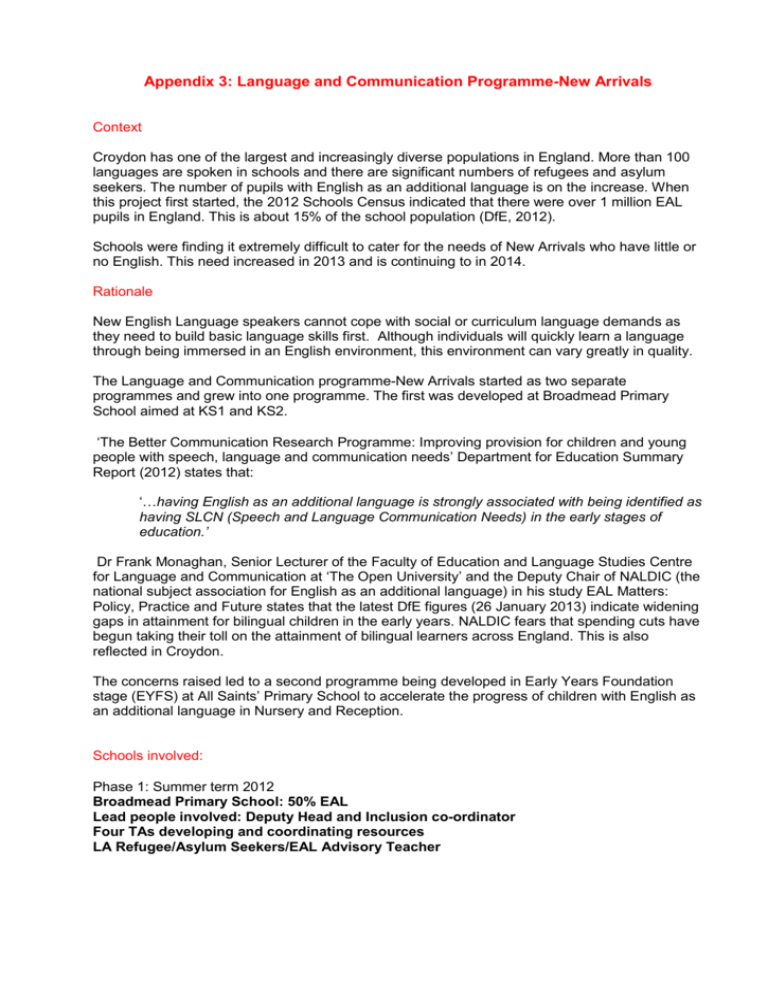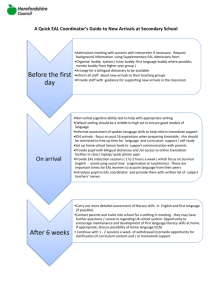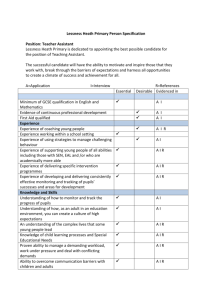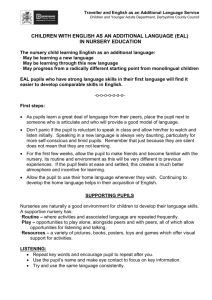CSF 19 Jan 2015 Item 3 Appendix 3 Language
advertisement

Appendix 3: Language and Communication Programme-New Arrivals Context Croydon has one of the largest and increasingly diverse populations in England. More than 100 languages are spoken in schools and there are significant numbers of refugees and asylum seekers. The number of pupils with English as an additional language is on the increase. When this project first started, the 2012 Schools Census indicated that there were over 1 million EAL pupils in England. This is about 15% of the school population (DfE, 2012). Schools were finding it extremely difficult to cater for the needs of New Arrivals who have little or no English. This need increased in 2013 and is continuing to in 2014. Rationale New English Language speakers cannot cope with social or curriculum language demands as they need to build basic language skills first. Although individuals will quickly learn a language through being immersed in an English environment, this environment can vary greatly in quality. The Language and Communication programme-New Arrivals started as two separate programmes and grew into one programme. The first was developed at Broadmead Primary School aimed at KS1 and KS2. ‘The Better Communication Research Programme: Improving provision for children and young people with speech, language and communication needs’ Department for Education Summary Report (2012) states that: ‘…having English as an additional language is strongly associated with being identified as having SLCN (Speech and Language Communication Needs) in the early stages of education.’ Dr Frank Monaghan, Senior Lecturer of the Faculty of Education and Language Studies Centre for Language and Communication at ‘The Open University’ and the Deputy Chair of NALDIC (the national subject association for English as an additional language) in his study EAL Matters: Policy, Practice and Future states that the latest DfE figures (26 January 2013) indicate widening gaps in attainment for bilingual children in the early years. NALDIC fears that spending cuts have begun taking their toll on the attainment of bilingual learners across England. This is also reflected in Croydon. The concerns raised led to a second programme being developed in Early Years Foundation stage (EYFS) at All Saints’ Primary School to accelerate the progress of children with English as an additional language in Nursery and Reception. Schools involved: Phase 1: Summer term 2012 Broadmead Primary School: 50% EAL Lead people involved: Deputy Head and Inclusion co-ordinator Four TAs developing and coordinating resources LA Refugee/Asylum Seekers/EAL Advisory Teacher Impact summary: 10 week trial on four pupils until summer 2012 In the first 10 weeks of the programme at Broadmead Primary School, 100% of the Children had made above expected progress.33%of the pupils had made 2 sub-levels progress. 67% had made 3 sub-levels progress and above even though they had very little English on arrival. Autumn term 2012 10 weeks 100% of the children had made accelerated progress of one sub level in 10 weeks. The class teachers observed that there had been an improvement in just four weeks in all the children following the programme. They were able to respond to straightforward comments/ instructions addressed to them and to communicate in English. Above all, 71% of the children had shown considerable improvement in confidence and self-esteem. Spring 2014-one and a half terms The impact on children’s progress in Speaking, Listening, Reading and Writing was assessed using the extended scales. In Year 1, the progress made was above national expectations and some children had made excellent progress – 5 or 6 points in 1 ½ terms. (National expectations for all pupils in Key Stage 1 is 4 points per year). Achieving above three points in this time is considered to be accelerated progress. In Year 2, the progress again exceeded national expectations with some children making 5-8 points progress in 1 ½ terms. The Key Stage 2 early morning group started on the 09.06.2014. This involved 7 children across years 3, 4 and 5. Parents were very supportive and pleased for the opportunity. Phase 2: Summer term 2012 All Saints Primary School is a two form entry school; similar in catchment to Broadmead 50% of the children in Early Years have English as an Additional language. People involved: All Saints’ Primary School- Assistant Head EYFS co-ordinator EAL Croydon Council -Refugee/Asylum Seekers/EAL Advisory Teacher Early Language Consultant and Makaton Trainer-Croydon Council Other agencies: Health: Speech and Language Therapist Team Leaders- Sanderstead Clinic: Head of the Oracy Project Team Leader for the Pre-School team (Bilingual specialism) The Oracy Project had been running in a number of schools to address the needs of the language deprived. It seemed logical to work in partnership with Health thereby also reducing the number of unnecessary referrals to the speech and language services. Although the aim of the programme was to help children with English as an additional language, it was also hypothesised that this approach would also work for language deprived children. The Broadmead scheme of work had proven to be a success therefore it was the logical starting point. A two pronged approach was adopted initially. Daily small group sessions of 15 mins. were run in Nursery for those new to English, alongside daily whole class sessions reinforcing topical vocabulary and modelling sentence structure for all children. In Reception the school also ran twice weekly sessions of 30 minutes duration, alongside daily whole class sessions. Parents of the children new to English have been very pleased with progress in understanding and speaking. Impact summary: From September 2013: After 5 weeks: All the children have responded well to the language and some parents have commented on how their children’s vocabulary has improved. A completely silent child started whispering words for the very first time The whole class has benefitted from the project After 10 weeks: Progress in Nursery after 10 weeks is also evident. The children that had been using very little English now have basic words and some phrases and sentences. Parents have noticed the progress in language Summer 2013 The school’s tracking progress monitoring system has shown that from “On entry” to Spring 2, most children in their new to English groups have made at least 2 subgroups progress, some made 3 and one child made 5 levels progress in speaking All Saints’ will continue to use the project next year. Impact in Nursery has exceeded expectation. Summer 2014 “On entry” to Summer 2, 87% of children made accelerated progress in speaking (4 - 7 sub levels). 13% made the expected 3 sublevels progress. The programme has also benefitted the rest of the class as it is embedded in whole class teaching. On entry, in September 2013, 88% of the Nursery pupils were levelled at below age-related in speaking. After two terms 29% of nursery pupils were levelled below age-related in speaking. At the end of the year, only 16% of children were below age-related levels in Speaking (these children are all receiving support for speech and language issues or have special needs). The parents of the children new to English have been very pleased with progress in understanding and speaking and this has obviously had a positive impact on attention and listening. All Saints’ will continue to work in the same way next year and continue to add to their basic plan for developing English in early years. Overall impact: The majority of children who embark on the ‘Language and Communication Programme- New Arrivals achieve accelerated progress (at least one sub-level in ten weeks). This is not only reflected in the target schools but also in the other schools participating in the programme. One infant school noticed a positive impact in just two weeks across the school. This particular school has found it particularly useful for their Gifted and talented pupils. The impact is best when embedded in whole class teaching. All the schools who have trialled the programme successfully incorporated it as part of their planning. Yvonne Cassidy, EAL Advisory Teacher July 2014 .





![afl_mat[1]](http://s2.studylib.net/store/data/005387843_1-8371eaaba182de7da429cb4369cd28fc-300x300.png)

